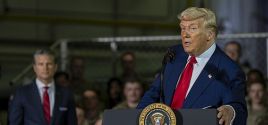Commercial Drones Declared Legal; Release The Tacocoptersby Mike MasnickTechdirt Mar. 10, 2014 |
Popular 
U.S. Official Denies Report Trump Team Told Israel 'We Will Abandon You' If You Don't End Gaza War

Ben Shapiro, Mark Levin and Laura Loomer Warn of Foreign Influence... From Qatar

Eloy Adrian Camarillo, 17, Arrested in Shooting Death of Infowars Reporter Jamie White

Report: Hamas Says Witkoff Promised to Lift Gaza Blockade in Exchange for Edan Alexander

NYT: Trump Ended War With Houthis After They Shot Down U.S. Drones, Nearly Hit Fighter Jets
 Almost exactly two years ago, we wrote about the tacocopter, a sort of proof of concept idea for using drones to deliver products to people's homes. Yes, Amazon got some attention last year for claiming to be working on something similar, but the Tacocopter (and Lobstercopter on the east coast) idea was the first I'd heard of anyone seriously thinking about commercial-use drones. However, the key point of our Tacocopter story was that they were illegal: Current U.S. FAA regulations prevent ... using UAVs [Unmanned Aerial Vehicles, like drones] for commercial purposes at the moment.Well, that's no longer the case apparently. National Transportation Safety Board (NTSB) administrative law judge Patrick Geraghty has unleashed the tacocopters of the world by issuing a ruling that the FAA has no mandate to regulate commercial drones. The case involved the first time that the FAA had actually tried to fine someone, a guy named Raphael Pirker, $10,000 for trying to film a commercial with a drone at the University of Virginia. The issue, basically, is that the FAA has historically exempted model airplanes from its rules, and the NTSB finds it impossible to square that with its attempt to now claim that drones are under its purview. As Geraghty notes, accepting that leads to absurd arguments about the FAA's mandate over all flying objects: Complainant has, historically, in their policy notices, modified the term "aircraft" by prefixing the word "model", to distinguish the device/contrivance being considered. By affixing the word "model" to "aircraft" the reasonable inference is that Complainant FAA intended to distinguish and exclude model aircraft from either or both of the aforesaid definitions of "aircraft".The judge notes that while the FAA had some internal memorandum about these issues, it did not put forth a full rule, and thus it is not an actual policy. As a result, the ruling finds that the current definition of aircraft is not applicable here and thus the FAA has no real mandate over this kind of drone. This does not preclude the FAA from trying to go through a full rule-making process to try to gain a mandate over commercial drone use, but that will involve a big political fight. It's way easier to block something like that from becoming official than overturning it if it was already deemed the law. Pirker Decision (PDF) |



